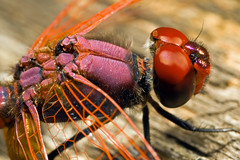I’ve spent the last month experimenting with different ways to mount the flash heads on my MT-24EX to minimize reflection. I like to use one flash head for fill, and the other as a direct light to bring out the detail in the critter that I’m photographing. Placing both flash heads close to each other at the top of the lens makes it easier to reduce reflections and to determine which one is causing problems if an area of the image is blown out.
What I found during all my trial and error was that it’s best to point the fill flash head toward the area where the subject would be, and then turn the flash head away from the lens “one click” –the MT-24EX’s flash heads can rotate a little and there are stops that you can feel as you turn them. So the fill flash is still pointed down, but not toward the subject.
The flash head I use to directly illuminate the subject can be pointed directly at the critter I’m photographing, but I sometimes have to point it down “one click” to avoid reflections from it. The down side to using the flash heads that way is that sometimes the resulting image is a little under exposed, but usually by no more than 2/3 of a stop –easy to correct for in post processing.
The image with this post is an example of what I’ve been able to do with the MT-24EX. There are some hot spots on the nose, but nothing that’s completely blown out.
When shooting close to life size sunlight reflecting off of shiny areas can be a problem as well, so pay attention to any hot spots that you see in the view finder. Eliminating them can be as simple as shifting your position no more than a few millimeters.


No comments:
Post a Comment